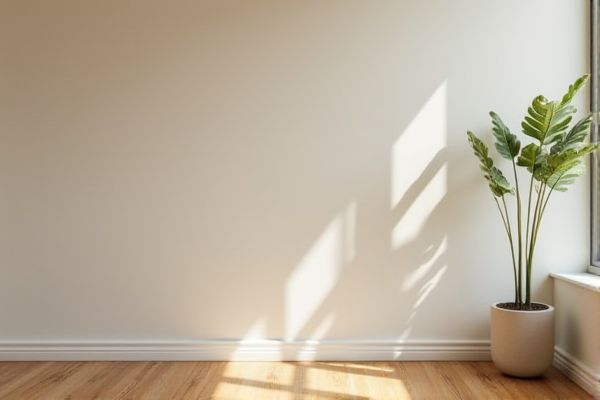
Moisture barrier paint provides superior protection against water infiltration and mold growth compared to standard paint, which primarily offers aesthetic appeal without specialized resistance. Discover how choosing the right paint can safeguard your surfaces and enhance durability by reading the rest of the article.
Table of Comparison
| Feature | Moisture Barrier Paint | Standard Paint |
|---|---|---|
| Primary Function | Prevents water vapor and moisture penetration | Provides color and surface finish |
| Water Resistance | High - blocks moisture effectively | Low to moderate - no moisture blocking |
| Durability in Damp Areas | Excellent - ideal for basements, bathrooms | Poor - prone to peeling and mold growth |
| Mold and Mildew Resistance | Enhanced resistance properties | Limited or none |
| Application Areas | Concrete, masonry, and high-humidity zones | Dry, indoor walls and ceilings |
| Cost | Higher due to specialized formula | Lower and widely available |
| Common Usage | Basement walls, exterior foundations, bathrooms | Living rooms, bedrooms, general indoor surfaces |
Introduction to Moisture Barrier Paint vs Standard Paint
Moisture barrier paint is specially formulated to prevent water vapor from penetrating surfaces, making it ideal for areas prone to dampness and mold growth. Standard paint primarily serves decorative purposes and offers limited protection against moisture, potentially leading to peeling and mildew in humid environments. Choosing moisture barrier paint enhances the durability of your walls by providing a protective shield against moisture-related damage.
Understanding Moisture Barrier Paint: Key Features
Moisture barrier paint is designed with advanced waterproofing technology to prevent moisture penetration and resist mold growth, making it ideal for damp environments. Unlike standard paint, it contains specialized polymers and additives that create a dense, protective seal to block water vapor and humidity. This paint enhances durability on surfaces prone to moisture damage, offering long-lasting protection compared to conventional paints.
Standard Paint: Composition and Common Uses
Standard paint consists primarily of pigments, binders, solvents, and additives, designed to provide color and surface protection on interior and exterior walls. Commonly formulated with organic compounds and water-based or oil-based solvents, standard paints offer a balance of coverage, drying time, and finish quality suitable for general-purpose applications in residential and commercial environments. They lack specialized moisture-resistant components found in moisture barrier paints, making them less effective in preventing water vapor penetration and mold growth in high-humidity areas.
How Moisture Barrier Paint Works
Moisture barrier paint creates a protective layer that prevents water vapor from penetrating surfaces, reducing mold growth and structural damage. It contains special resins and additives that form a continuous, waterproof membrane, sealing porous materials like concrete or wood. This paint is especially effective in high-humidity areas, maintaining indoor air quality and prolonging the lifespan of walls and ceilings.
Performance Comparison: Moisture Resistance
Moisture barrier paint offers significantly higher resistance to water vapor penetration compared to standard paint, effectively preventing mold growth and structural damage in high-humidity environments. Unlike standard paint, which may absorb moisture and degrade over time, moisture barrier coatings create a waterproof seal that extends the lifespan of walls and ceilings. This enhanced moisture resistance makes moisture barrier paint ideal for basements, bathrooms, and other areas prone to dampness.
Application Areas: Where Each Paint Excels
Moisture barrier paint excels in high-humidity areas such as basements, bathrooms, and kitchens by effectively preventing water vapor penetration and mold growth. Standard paint is suitable for dry indoor spaces like living rooms and bedrooms, providing aesthetic finishes without specialized moisture resistance. Choosing moisture barrier paint for your damp environments ensures long-lasting protection and maintains wall integrity.
Durability and Longevity Differences
Moisture barrier paint offers superior durability compared to standard paint by resisting water penetration and preventing mold growth, which significantly extends the lifespan of painted surfaces. Standard paint lacks this protective layer, making it prone to peeling, blistering, and degradation when exposed to moisture over time. Homes and structures using moisture barrier paint typically experience longer-lasting protection and reduced maintenance costs in humid or wet environments.
Cost Comparison: Moisture Barrier vs Standard Paint
Moisture barrier paint typically costs 20-40% more than standard paint due to its advanced formulation that provides superior protection against water damage and mold growth. While the initial investment is higher, moisture barrier paint can save you significant expenses in repairs and maintenance by preventing moisture-related structural issues. Your choice should consider long-term durability and environmental conditions to ensure cost-effectiveness.
Maintenance and Upkeep Requirements
Moisture barrier paint significantly reduces maintenance and upkeep by preventing water infiltration, mold growth, and peeling, unlike standard paint which often requires frequent touch-ups and repairs due to moisture damage. Its advanced formulation provides long-lasting protection, minimizing the need for repainting and costly remediation efforts. Regular inspections confirm the integrity of moisture barrier coatings, ensuring sustained durability and reduced labor compared to standard paint maintenance cycles.
Choosing the Right Paint for Your Project
Moisture barrier paint offers enhanced protection by preventing water vapor penetration, making it ideal for high-humidity areas and exterior surfaces exposed to harsh weather. Standard paint provides basic color and finish but lacks the specialized formulation to resist moisture, often leading to peeling or mold growth in damp conditions. Selecting between these paints depends on environmental exposure, with moisture barrier paint being essential for durability and mold prevention in moisture-prone spaces.
 homyna.com
homyna.com